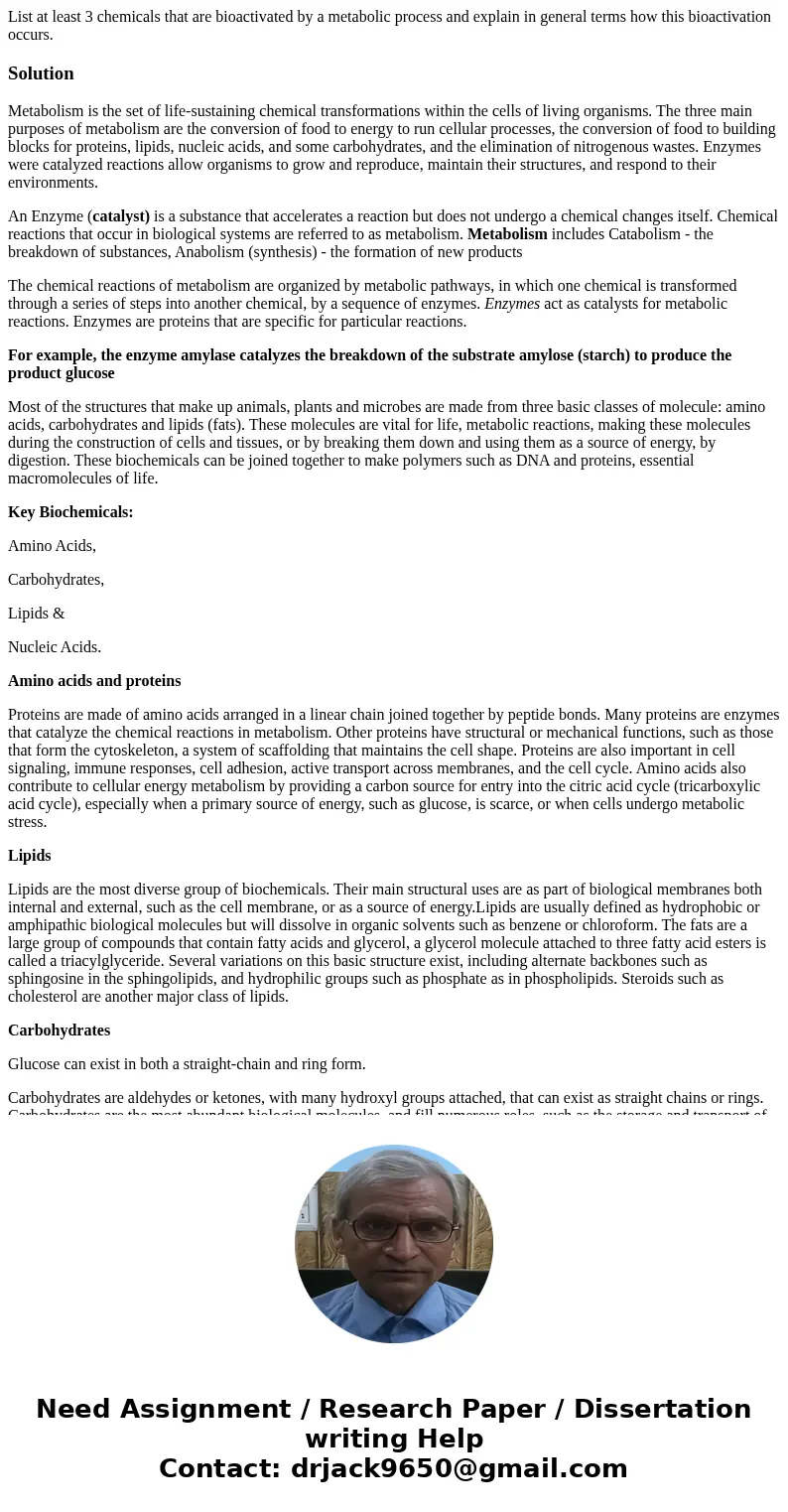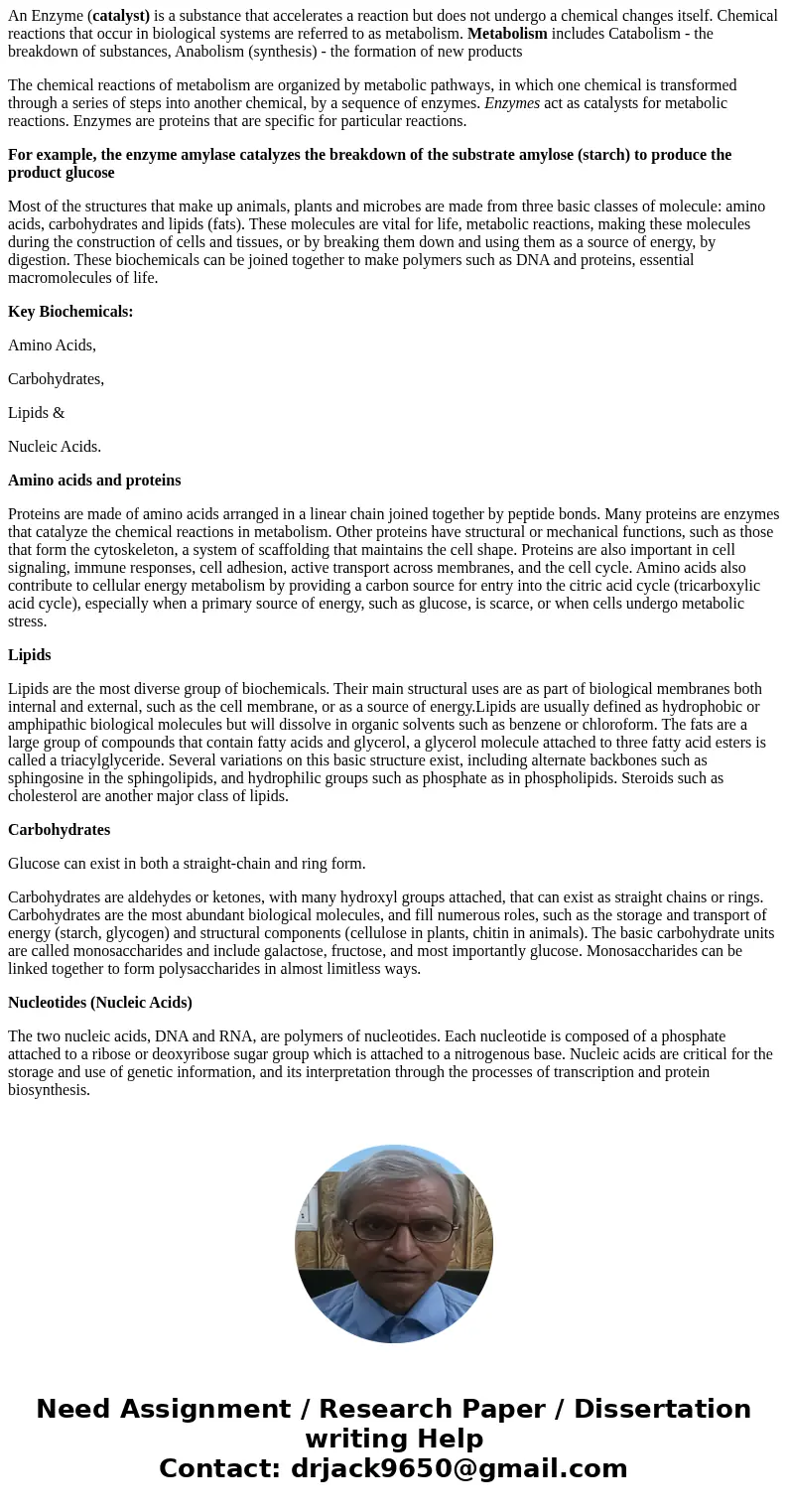List at least 3 chemicals that are bioactivated by a metabol
Solution
Metabolism is the set of life-sustaining chemical transformations within the cells of living organisms. The three main purposes of metabolism are the conversion of food to energy to run cellular processes, the conversion of food to building blocks for proteins, lipids, nucleic acids, and some carbohydrates, and the elimination of nitrogenous wastes. Enzymes were catalyzed reactions allow organisms to grow and reproduce, maintain their structures, and respond to their environments.
An Enzyme (catalyst) is a substance that accelerates a reaction but does not undergo a chemical changes itself. Chemical reactions that occur in biological systems are referred to as metabolism. Metabolism includes Catabolism - the breakdown of substances, Anabolism (synthesis) - the formation of new products
The chemical reactions of metabolism are organized by metabolic pathways, in which one chemical is transformed through a series of steps into another chemical, by a sequence of enzymes. Enzymes act as catalysts for metabolic reactions. Enzymes are proteins that are specific for particular reactions.
For example, the enzyme amylase catalyzes the breakdown of the substrate amylose (starch) to produce the product glucose
Most of the structures that make up animals, plants and microbes are made from three basic classes of molecule: amino acids, carbohydrates and lipids (fats). These molecules are vital for life, metabolic reactions, making these molecules during the construction of cells and tissues, or by breaking them down and using them as a source of energy, by digestion. These biochemicals can be joined together to make polymers such as DNA and proteins, essential macromolecules of life.
Key Biochemicals:
Amino Acids,
Carbohydrates,
Lipids &
Nucleic Acids.
Amino acids and proteins
Proteins are made of amino acids arranged in a linear chain joined together by peptide bonds. Many proteins are enzymes that catalyze the chemical reactions in metabolism. Other proteins have structural or mechanical functions, such as those that form the cytoskeleton, a system of scaffolding that maintains the cell shape. Proteins are also important in cell signaling, immune responses, cell adhesion, active transport across membranes, and the cell cycle. Amino acids also contribute to cellular energy metabolism by providing a carbon source for entry into the citric acid cycle (tricarboxylic acid cycle), especially when a primary source of energy, such as glucose, is scarce, or when cells undergo metabolic stress.
Lipids
Lipids are the most diverse group of biochemicals. Their main structural uses are as part of biological membranes both internal and external, such as the cell membrane, or as a source of energy.Lipids are usually defined as hydrophobic or amphipathic biological molecules but will dissolve in organic solvents such as benzene or chloroform. The fats are a large group of compounds that contain fatty acids and glycerol, a glycerol molecule attached to three fatty acid esters is called a triacylglyceride. Several variations on this basic structure exist, including alternate backbones such as sphingosine in the sphingolipids, and hydrophilic groups such as phosphate as in phospholipids. Steroids such as cholesterol are another major class of lipids.
Carbohydrates
Glucose can exist in both a straight-chain and ring form.
Carbohydrates are aldehydes or ketones, with many hydroxyl groups attached, that can exist as straight chains or rings. Carbohydrates are the most abundant biological molecules, and fill numerous roles, such as the storage and transport of energy (starch, glycogen) and structural components (cellulose in plants, chitin in animals). The basic carbohydrate units are called monosaccharides and include galactose, fructose, and most importantly glucose. Monosaccharides can be linked together to form polysaccharides in almost limitless ways.
Nucleotides (Nucleic Acids)
The two nucleic acids, DNA and RNA, are polymers of nucleotides. Each nucleotide is composed of a phosphate attached to a ribose or deoxyribose sugar group which is attached to a nitrogenous base. Nucleic acids are critical for the storage and use of genetic information, and its interpretation through the processes of transcription and protein biosynthesis.


 Homework Sourse
Homework Sourse